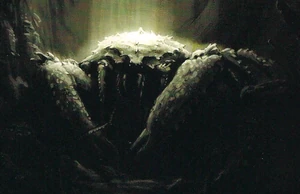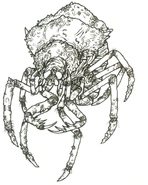|
Abyscidis
| |
|
Name:
|
Abyscidis occisor
|
|
Abilities and Weapons:
|
armour, claws, senses
|
|
Occupation:
|
Scavenger
|
|
Home:
|
Skull Island
|
|
First Appearance:
|
"King Kong" (from 2005)
"The World of Kong: A Natural History of Skull Island" (from 2005) |
|
Diet:
|
Carnivore (carrion)
|
|
Size:
|
Length: 30-60 centimeters
Weight Estimated: 0.6-1.1 kilograms |
|
Status:
|
Presumably extinct. Unlikely to survive Skull Island's destruction.
|
Abyscidis occisor ("killer crab of the abyss"), is a species of crustacean that is found on Skull Island. The animal is described in the book "The World of Kong: A Natural History of Skull Island" (2005).
Facts[]
Abyscidis were dog-sized crustaceans that lived in the shadows of the larger flesh eaters of the dark. Primarily scavengers, they were unparticular feeders, taking any organic matter they could scavenge, dead or dying. The chunky invertebrates cluster in loose colonies at the base of a pit or in deep caves. The nymphs, hatching in large numbers, use the rivers of organic slop to migrate around their dark domain, locating an unclaimed section of cave or chasm shoreline to mature in and establish a new colony.
A. occisor is a good 1-2 feet long (30-60 centimeters); a smaller relative of the mighty Deplectors that clung to the walls of the Abyssal chasms.
Appearance in the Film[]
The Abyscidis were present with Arachno-Claw in the chasm, climbing down the walls with their pincers and scavenging for carrion. When Jack, Jimmy and Carl kill the first wave of bugs, the Arachno-Claw and Abyscidis came from all directions and tried to eat the remaining crew but Captain Englehorn and a few other crewmen shot from above the chasm, killing almost every bug in the chasm including the Abyscidis along with some Deplectors and Arachno-Claws. Some of which were shot from their holes in the walls, causing them to fall down and hang from the vines and crush other insects below.
Gallery[]
Trivia[]
- They resemble the Cunaepraedator of the associated video game.
- They can be mistaken for Deplectors because of their similar claws.
- Like most creatures from the Pit. It is unlikely they survived the island's destruction given the sheer dangers of the Pit and difficulties of logistics in trying to garner some specimens. In contrast to the majority of the wildlife where sufficient tranquilizers would have been enough to immobilise them for study at ground-level.



